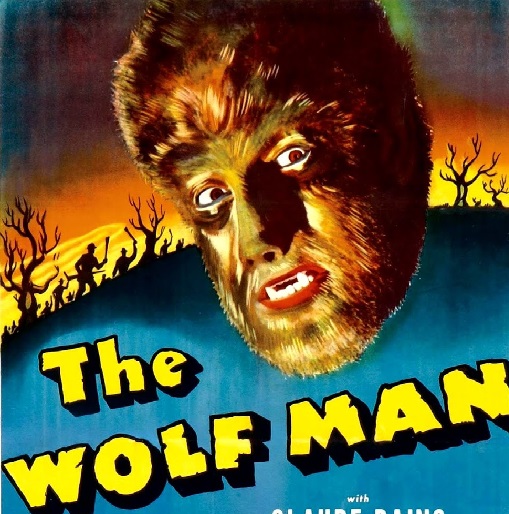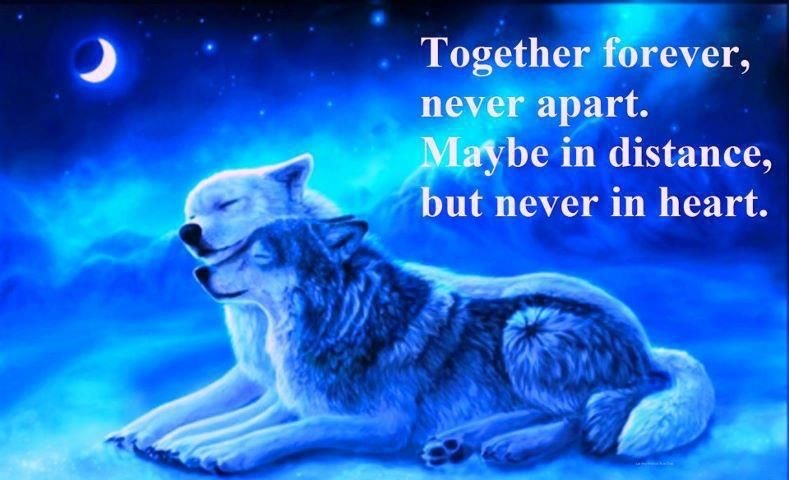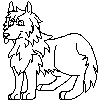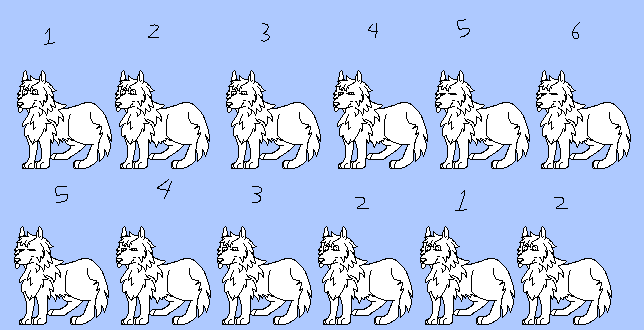
For years, wolves have crept through the shadows of human consciousness. They’re the villain of cautionary tales for children. They’re monstrous beasts. Werewolves. Symbols of evil, deception, and raw animal prowess. At the same time, they are symbols of nature and goodness.
The wolf occupies a strange dual nature within how we perceive them, equally villainized and mysticized. I, however, have always known the wolf by a different, newer reputation, and I suspect many others have too. And, for many youths of the current era, we knew the wolf by its new reputation: a symbol of misunderstood outcasts, of cathartic anguish, of loyalty and determination.
How has this shifted? Why have wolves been an enduring symbol of self identification for so many “weird kids”- the wolf girls, the wolfaboos, the furries, etc? What does it mean- to become a werewolf? That is what this page hopes to explore.
(As a side note, I use the word “amateur” a lot here to describe art, videos, etc.- this is not meant as a negative descriptor! It’s meant to clarify that these things are made non-professionally or by young people. I would describe my own dabbling in certain mediums as “amateur” as well.) Additionally, while I mostly write based on my perspectives as an LGBT autistic girl and as such relate a lot of these points to being neurodivergent, a girl, or being LGBT, the idea of "outcast status" is meant to be extrapolated outward. If the wolf resonates with you, it resonates!
Why don’t you follow me through my territory? There’s so, so much to see.
 The Nonfictional Wolf
The Nonfictional Wolf 
The wolf and its many subspecies have existed for hundreds of thousands of years. They are carnivorous apex predators that live in family units called “packs”, consisting of the breeding pair and offspring. Wolves predate on ungulates like elk, caribou and deer but can also target smaller prey like hare, beavers, etc and have even been recorded fishing. The pups are raised inside a den within the large, maintained territory until they are old enough to move to a “rendezvous site”, where they will mature and learn to hunt. Adult pups will linger with the pack to help raise the breeding pair’s next litter, but will eventually “disperse” from the pack and find their own mate to start their own pack, thus repeating the cycle.

Here are some fun wolf facts:
-A wolf pack can feed on a single carcass from a hunt for several days.
-Wolves in some areas have been recorded feeding on blueberries during the summer months.
-Wolves express themselves via body language like tail or ear positions in addition to using vocalizations or scent.
-A wolf’s howl can be heard from up to 7 miles away.
-Wolf pups are born with blue eyes, but most turn yellow as they mature.
-A wolf can run up to 40 miles per hour.
-Wolves and ravens have a mutualistic relationship, with ravens leading wolves to carcasses as well as feeding off of pack kills.
-Wolf pack hierarchy is considered outdated and inaccurate to wild wolves, but they may form pecking orders when kept in captivity.
-Wolf claws aren’t used for attacking, but rather for grip.
When you look at just the facts, the image of the wolf seems like a simple one. However, wolves have often been mystified by misinformation or outdated science (see: the pervasive “alpha wolf” myth). In some ways there are more fictions surrounding the wolf than there are facts. It makes sense, though. Wolves have existed for a long, long time, always, in a way, at humankind’s side. They have been our constant companion; why else would they be domesticated into dogs? Why else would they haunt so many stories we tell?
Why else, within the consciousness of mankind, would the wolf be more icon than living creature?
 Evolution of the Fictional Wolf
Evolution of the Fictional Wolf 
As I mentioned at the beginning, the wolf-as-icon holds a dual nature. I will call these two natures the “Big Bad Wolf” and the “Spiritual Wolf”, two extremes.
The Big Bad Wolf, as the name implies, is the fairytale creature; it is the horror movie werewolf. It threatens to devour our virtuous protagonists; it lurks as a danger, it’s the beast that stalks the night and a genuine danger. Most werewolf media squarely places the werewolf as a Big Bad Wolf, incapable of control of its animal urges and constantly killing, killing, killing. The Big Bad Wolf is also associated with masculinity and sexuality. They're the manly men, the jocks, the symbols of masculine and virile power. The Big Bad Wolf is a beast that must be feared, and this reputation has influenced real-world views and opinions of the animal.

The idea of the Spiritual Wolf is one of reverence for the wolf and nature, and is closely associated with misappropriated “native” aesthetics. These wolves are wise, spiritual guides, and more symbol than character. In these cases, the wolf is often used as a representation of the natural world as a concept. The Spiritual Wolf is the opposite of the Big Bad Wolf, in that it can do no wrong. The Spiritual Wolf is neither explicitly feminine nor masculine; it can be either. It's like the infamous Three Wolf Moon shirt.
(As a side note, I distinctly remember writing a werewolf story for a class in elementary school and putting this image in the word document because I was so excited to see artwork of a female werewolf that wasn’t “too human”. I just knew I had to find it again for this project! Unfortunately I don’t have a source at the moment...)
Within this piece of writing I intend to make the case that within the youth of the internet age, a new archetype has arisen. For lack of a better name, I suggest “Fursona Wolf”, as it correctly emphasizes the importance of self-identity to this new breed, though I feel like it is a separate phenomenon to wider Furry culture (for one thing, these wolf characters are often quadrupedal rather than “anthro”, and often exist within explicitly xenofiction settings as oppozed to the anthropomorphic lives depicted in furry art. It’s a rectangles and squares kind of situation). It seems close to the “Spiritual Wolf” at first glance, perhaps even indistinguishable, but I would argue its close ties to “cringe” youth subculture, art, and expression, make it a unique new category that has had a significant uptick over the last few decades, particularly during the internet age- and I would argue that the reputation of the Big Bad Wolf also adds to why identifying with the wolf was so alluring for so many of us. This is something I can only prove anecdotally, because I was part of that shift.

The change in perception of wolves amongst the youth can be seen in this 2007-era devlog from WolfQuest (more on that later):
“We’ve been talking to a lot of kids lately about the WolfQuest game to find out what they know about wolves (...) and we’ve been pleased that very few have negative attitudes about wolves. As far as this generation is concerned, the big bad wolf has left the building. In fact, we’re seeing just the opposite. Kids love wolves. Kids think that wolves are smart—really smart. And strong. And spiritual. And pretty. And good parents to their pups. All these are true (well, I can’t vouch for “spiritual”). (...) And because our game will portray wolves more accurately—killing sheep, etc.–we need to anticipate how kids will assimilate these new ideas about the animal...”
The appeal of wolves to children is pretty obvious. They're like dogs- cute and cuddly and already well loved in human society- but more badass and more misunderstood. Imagining life in the wilderness rather than within the human world also lends escapism to the wolf fantasy, but erroneous beliefs about pack dynamics can make for easy and relatable stories of social ostracization- being bullied or unliked among peers can make you feel like an “omega”. And, crucially, many outcasts- the neurodiverse; young girls; LGBT youths; other bullying victims- can relate to feeling like everyone misunderstands you, like the wolf, hated by so many for just trying to survive. Thus, the reputation of the Big Bad Wolf is just as much an ancestor to this archetype as the reputation of the Spiritual Wolf.
Additionally, this archetype may have simply risen in popularity during the internet age due to the many new avenues through which young people could share art and ideas in a way that wasn’t possible before. The internet of this era also stands as a place for the young or socially awkward to socialize and express themselves through a different persona via anonymity, in ways they might keep leashed in the meatspace. And what better place to share your new wolf OC? And play- our hobbies, our art, our games, our fun- is how we explore concepts unfamiliar to us. Like a wolf pup learning through play-fighting with its littermates, we explore the unfamiliar and upsetting through our online "play", our angsty wolfsonas with bloodstained backstories. All this comes to life within internet teen subculture.
What better place to express what may otherwise be hidden?
 Hear the She-Wolves Howl
Hear the She-Wolves Howl 
The Fursona Wolf is not itself inherently feminine or female, but it is closely tied to feminine expression. This can be seen in contemporary art among youths within deviantArt OC and "sparkledog" culture- the Fursona Wolf was and is especially popular among preteen girls. Its place within youth culture is directly in contrast to the masculine symbolism of the Big Bad Wolf, and the framing is much different from even preceding female wolves and werewolves within fiction.
For example, the film Ginger Snaps features a female werewolf antagonist, with a specifically feminine perspective- Ginger’s lycanthropy is a metaphor for worries surrounding puberty and maturing into a woman. As she gradually becomes more of a wolf, she becomes more sexually active, angry, assertive, and more and more distant from her sister. However, her finding freedom and liberation within her transformation is, thematically, evidence of her going astray and becoming more and more of an antagonist- a monster. Her canine power is explicitly a thing of evil within the text; she’s an uncontrollable killer, and her rage- and womanhood- is demonized. By the end, when she has fully become a werewolf, she must be put out of her misery and killed, not even getting to be freed with the Monkshood cure. In Ginger Snaps, to become a wolf is to be too far gone- and to be a woman is to be a wolf.
However, the violent and wild life of the Fursona Wolf is celebrated and valorized by its followers. Its rage and sorrow are not what make it monstrous, but rather what gain it sympathy from its audience. I intend to outline one of the more popular wolf-based amateur series, the tropes these narratives play into, as well as the unique ways they speak to this experience through their emotionally complex and often subversive female characters.
The Blackblood Alliance, a popular comic on deviantArt from 2007 by the artist KayFedewa, is the most prominent clear cut example of this. The protagonist, Swiftkill, gains her power from her uncontrollable rage, and is exiled from her pack as a result due to an event where she accidentally murders a few pups she was attempting to protect, in a situation that is, within the text, explicitly not her fault.
Though BBA was a very short-lived comic, we were allowed a short glimpse at into the interiority of Swiftkill's emotions- betrayal, rejection, guilt- to an extent that is not typically permitted for female characters, nor are they typically allowed to take such proactive roles. Swiftkill and her fellow Blackbloods are the only hope for the wolves to win a vicious war, something explicitly tied to her strength and power in battle, abilities which are more typically associated with masculinity. Swiftkill's archetype, the cool and aloof loner, is also predominantly a trope that is applied to male characters. In some ways, it's revolutionary to allow female characters to have ugly, complex and negative emotions and have that be a reason to sympathize with them.
Though the comic ended abruptly, there was a reboot, and the series' creator has continued drawing the characters from BBA as recently as 2023 (the current year, as of writing). The comic is the archetypical "edgy wolf comic" and, according to contemporary sources, inspired many fans and imitators- often featuring “edgy”, depressed, angry, grieving or otherwise “negatively” expressive female protagonists, similar to Swiftkill. Their emotions are taken seriously and a reason for the audience to sympathize with and identify with their struggles. These characters suffer a lot of loss and hurt, specifically for the audience to find solace in.
(Another example of a character like this is the protagonist of the amateur animated movie Wolf Song, who pretty much experiences a conga-line of various traumas, including a deadbeat dad, failing to save her brother, her love interest dying, as well as being forced to kill her father just as she realizes who he is. Some may call this “tragedy porn” but these stories can be cathartic, especially when you’re young and trying to conceptualize concepts like death, trauma, guilt, and other unfamiliar ideas. It is to learn through play.)
As research for this shrine, I read and watched many of these amateur-created wolf comics, animations, and more. In many of them, characters were treated as outcasts, bullied, put low on the pecking order, targeted in war, or ostracized in some way. It’s a near universal trope of the genre. And within other, more professionally made, fiction enjoyed by this audience there are often similar themes (for example, Wolves of the Beyond prominently features the struggles of disabled wolves in a fictional wolf society, and the Balto series of films features the titular character as well as his offspring being bullied, distrusted, etc. for their half-wolf heritage- including his daughter, the main character of the Balto: Wolf Quest sequel movie; she eventually finds liberation from this outcast status by joining with a wolf pack and embracing the very thing that made her an outcast! I distinctly remember this movie being somewhat popular in these communities.)
One thing that surprised me most is that amateur wolf animation series are still being created on Youtube, with some being uploaded as recent as a few weeks or even days before I started researching for this project- some were made by children, and some were made by the adults who once were the children of the first “wolf animation” era. I think that’s beautiful! Something I had presumed to be a bygone era had indeed been continuing to survive under all our noses. This isn’t just a relic of a certain trend; there is something of a universal appeal here. The wolf never dies.
EDIT: Some time after this shrine was added to the site, I came across this lovely short film called Bolavlk/Wereawolf, which uses the imagery of sparkledogs and werewolves to tell a story about a young girl's rage at being groomed online. At the end, when she turns into her own fursona, it is a palpable moment of catharsis. Throughout the film, her fursona is both the means through which she is exploited (an online friend requests more and more inappropriate art of the character), but also the means of her self expression (for example, the scene where she's drawing vent art in class, as well as, of course, the scene where she shapeshifts into her fursona and she finally bites back.) This short film encapsulates every conclusion I came to during this project. It is one of the finest examples I've seen of the wolf as a symbol in this way. I would just advise heeding the trigger warnings in the description if you want to watch it!
I suppose the point is... It’s hard to be a preteen under any circumstances, especially as a “weird" preteen. To identify with the wolf and see it endure your struggles, to contend with the unfairness of the world around you, and express all the rage and grief you must swallow, is a powerful form of escapism.
 A Wolf Girl Playing Wolf Games
A Wolf Girl Playing Wolf Games 
I have said before that this phenomenon is one that can mostly be proven anecdotally; in addition to that, one of these anecdotes surrounds me. I was, indeed, a “wolf girl”. Yes, that kind of wolf girl, the one who was always howling on the playground and telling people to get off her territory. I was, in a word, “cringe”. (“Cringe” is meant positively here, as I am personally reclaiming the word for myself as an adult.) “Playing wolves” is, anecdotally, a particularly common subcategory of “playing pretend”.
I can’t really pinpoint when I started getting obsessed with wolves. They were kind of always there, in the same way that horses were always there for horse girls (including me. I was also a horse girl!), and so on. I would read as many books as I could find about wolves, people who interacted with wolves, werewolves, etc... I particularly remember reading White Fang, Call of the Wild, Wolves of the Beyond, The Incorrigible Children of Ashton Place, Julie of the Wolves, Wolven, etc... Just about anything with wolves in the title or on the cover would strike my fancy, no matter the quality of the writing. And I would write my own stories, too, centered on wolf characters, including one about two werewolf pen pals that was very clearly about some closeted lesbian feelings in retrospect. Through these stories I vented my feelings about school, about my family, about being “weird”. I had a “pack” consisting of the kids who sat at my table in 4th grade and our own wolfy personas. Identifying with the wolf and the werewolf simply came naturally to me. I told my peers I was actually a werewolf, and I sort of believed it. In a way I still do.
It was at that age that I came across a little game called WolfQuest. WolfQuest was created in 2007 as an edutainment game funded with a science grant, that showcased the life cycle of gray wolves in a careful recreation of Yellowstone National Park. I have continued to play WolfQuest for more than a decade now. I can’t begin to state the amount of love I have for it. I went from covetously looking at screenshots other people had posted on websites I had frequented, to discovering the game was free to play (at the time at least, the current version is paid). And, of course, I downloaded it- so I could finally “be a wolf”. It was everything I could have hoped for, and I made character after character with names like Silver or Luna or Flame or Shadow, raising their pups to adulthood and carefully crafting their stories. And there was multiplayer- oh, goodness, there was multiplayer, with over-the-top chat filters and a very carefully cultivated roleplaying culture and lingo. Every time I played a multiplayer game, I encountered so, so many people just like me. The wolf girls and the weirdos. My pack.

When I got into WolfQuest, the game was in a bit of a dark age. In short, the funding had run out in 2011, and the most recent update was to be the last one. They’d keep the servers for multiplayer online as long as they could, but the end was nigh. And though WolfQuest was a glitchy, glitchy game- practically falling apart at the seams- I loved it with my entire heart. I can’t understate the influence WolfQuest had on my wolfish obsessions, feeding into them while supplying me with (fairly accurate) science about the species. There was something powerfully escapist about being able to think and act entirely like a wolf without any of my petty human paranoias; it was pure immersion, to run and hunt and howl. At the same time, I felt utterly in control of the world, so much had I treaded over and over again through the two main maps and uncovered every possible glitch, exploit and oddity that lay in the surreal, low-poly hills of digital-Yellowstone. It was a world all my own.
(Nowadays, we've got the new and improved WolfQuest- Anniversary Edition, a new version of the game built from the ground up. It’s very, very good! I still play it often and keep up with new updates diligently. If anything I've shared about the game intrigued you I encourage you to try it out.)
Once I hit a certain age is when I really started internalizing the ideas of cringe culture, founded on the idea that making fun of children- for that same online self-expression I found so much freedom in- is entertaining or morally correct. I defaced my art; I renounced all my “Mary Sue” OCs; I became an ouroboros of hating everything that brought me joy. The wolf was muzzled.
And yet, I never stopped playing WolfQuest. Ever.
I think I had never given up on my greatest wish, even as I tried so hard to reject its place in my heart.
It’s time to admit I really, really wanted to become a werewolf. This is where the final piece of this puzzle lies.
 I Don’t Want To Be Human Anymore
I Don’t Want To Be Human Anymore 

“Werewolf spells” are poems, chants, and/or rituals spread over the internet, often by children and teens online (as indicated by the amateurish editing and spelling). They’re youtube videos, they’re articles, they’re webpages... There are variations- mermaid spells, vampire spells, etc. But the werewolf magic is the one I am most familiar with. Often they require you to recite a chant under the full moon; some are more complex and involved, requiring crystals, candles, etc. Many werewolf spells will list side effects and warnings but will also list benefits of the transformation. Like amateur wolf animations, I assumed that this was another trend that had died out in the mid-2010s, but I was surprised to see that there were still many similar werewolf spell videos made fairly recently, and with the same production values.
At the heart of them all is a desire to not be human anymore. There’s a certain desperation to all these wishes and incantations. I posit that these fervent wishes to become a werewolf are strongly tied to the outcast status that make the wolf such a favorite for self-identification.
Here is a passage from my girlfriend germicelli, who is speaking from a transfeminine perspective as well:
"fur and paws and teeth and freedom. the freedom of the wild. the freedom from an uncertain human future with all the hopelessness of a preteen looking forward. the hopelessness of someone who's barely had time to figure out what they want to be, but is already told they wont be enough. i want to be a wolf! after everything, after all of this. this human world is already so tired. i want to be a wolf!!!
Even though the hunger to wake up as something else exists as such a common childhood experience, especially among those that feel misunderstood... Something rarely given weight and understood yet something so powerful, and especially beautiful when revisited! Looking through several generations of primarily weirdgirl art its hard to ignore a common feeling that myself and many others have related to so personally and dearly. Maybe for just a moment, let yourself feel a little hunger for a world you can run free through. One where you dont have to clock in tomorrow."
I tried many of these spells myself when I was young! I even came up with some of my own on the fly, though I never published them. I tried so many; I tried them alone; I tried them at sleepovers; I tried on the full moon. It’s hard to say whether I genuinely believed they would work? But I did hope. I hoped a lot. (I remember once in particular I found a rumor that drinking rainwater from a wolf’s paw print would do the trick. To this day I have never found a wolf’s paw print, let alone one filled with rainwater, so jury’s still out on that one.)
It's hard to express but this feels so significant in retrospect. I felt fundamentally out of step with my peers, with other people, with the systems on which society is built, in ways that became some severe mental health issues later on in my adolescence. I responded to it by hoping for something. Anything. Any taste of that wild-blooded freedom, the thrill of the hunt and the comfort of a pack.
There are so, so many of these spells. So many people who hoped. Isn’t it beautiful? The weirdos of the world have cultivated our own mythology, our own rituals and faith of the internet age. And though some modern variants on the "real spell" (such as affirmations or hypnosis videos or what have you) are commonly mocked, they carry this same legacy, born of the same digital blood.
I think it's only right to create my own "spell", my own contribution to this digital tradition.

 Real Werewolf Spell
Real Werewolf Spell 
What does it mean, to be a werewolf? I think you should have a bit of idea based on my previous writings:
To be a werewolf is to reject repression. This spell is a promise to yourself.
A werewolf trusts its instincts and its joy. A werewolf rejects hierarchy. A werewolf lifts up others; a werewolf relishes joy and love among the outcasts. To transform is to be fully in touch with your feelings (Yes, even your most ugly or “cringe” feelings.) A werewolf howls.
To be a werewolf is to feel without fear.
![]() To perform the spell:
To perform the spell: ![]()
Under the full moon's light, create something you're ashamed of loving. Tell yourself it is beautiful. You don't have to share it.
Under the full moon's light, acknowledge an uncomfortable truth.
Under the full moon's light, accept sincerity and gnaw away at cynicism.
Under the full moon's light, howl out loud and make strange wolfish sounds.
Under the full moon's light, you are a werewolf.

 Conclusion
Conclusion 
In the end, we were all werewolves. Humans by day, with our secret double lives on the internet. Throughout the internet, wolves have kept their status as an enduring symbol of self-expression, a unique subculture that is above all a howling cry of downtrodden youths and weirdos all around the world. I believe this should be celebrated, and not forgotten. Not a lot of research has gone into these niche youth subcultures or what they mean to people; it’s more significant than anyone realizes to have an outlet like this.
I'm a werewolf. Are you?

Now for some free graphics!!! The idea is you can edit this button base with your own appearance as a wolf.

I've made a gif adopt base for anyone to edit and use as a pet as they see fit. In fact, it's deliberately made in a size that works well for Gifypet, with an additional background! The bases are below:



A link back isn't necessary but it is appreciated... :)
Say hello to my own wolf character, Choir Mooneye, who I play as in WolfQuest...
Now, I bid you adieu. You are always welcome on my territory.

